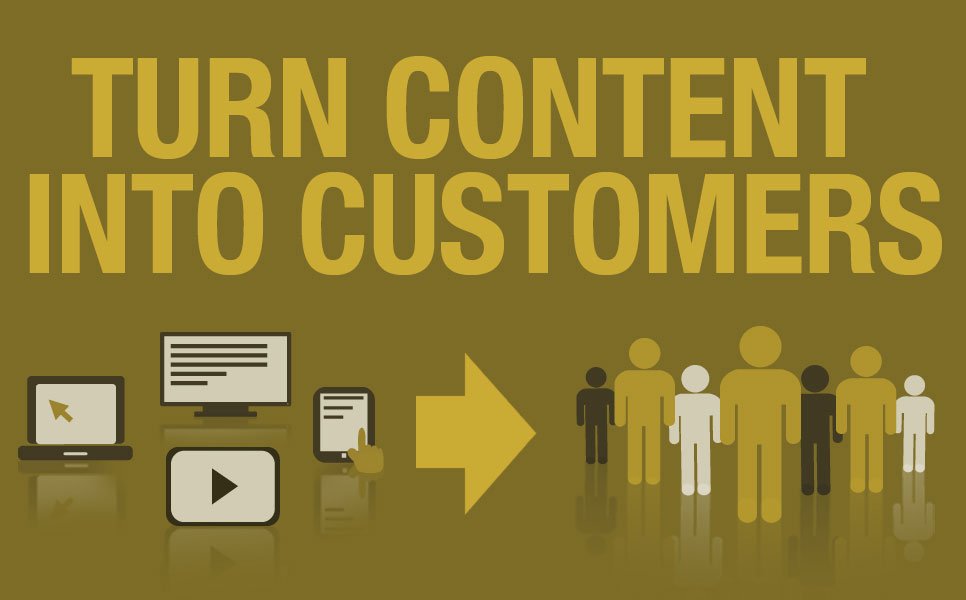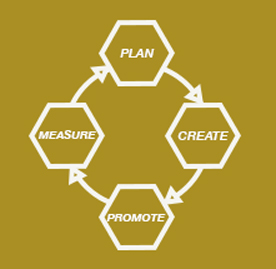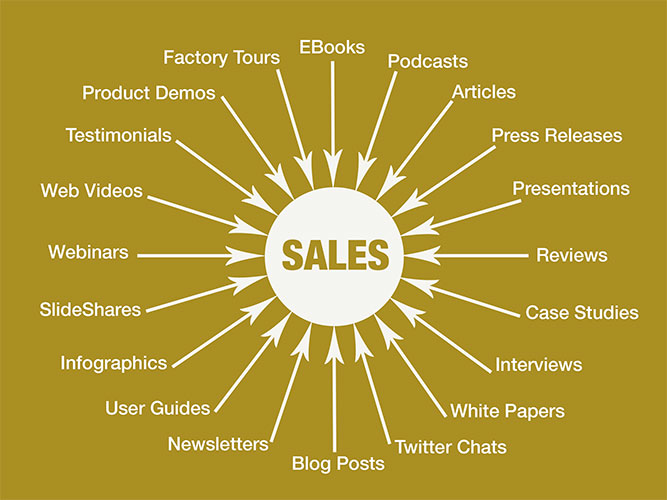What is Content Marketing?
The concept behind content marketing is relatively easy to grasp. By producing and publishing content that has value, you will engage with potential customers on a level above and beyond simple advertising or direct marketing.
The real key word in the previous paragraph is engage. We live in a world where most people filter out advertising. That’s why you need to find a newer vehicle to get your marketing message across, and content marketing is just such a vehicle.
Furthermore, content marketing is capable of far greater focus than other forms of marketing. It tends to attract highly motivated consumers—the kind of people who are likely to actually buy the products or services you sell.
The premise behind builder material marketing using content marketing is that by consistently putting out useful content about building materials, you are providing potential customers with added value. Over time, you will gain their trust and they will come to see you as an industry expert in the field of building materials. This means that when they are ready to make a purchase, they have already decided who the supplier will be. Content marketing can be an effective strategy for builder material marketing, as it allows you to showcase your knowledge and expertise in the industry while also providing valuable information to potential customers.
Content Marketing: A Four-Stage Process
Content marketing is driven by a simple, four stage iterative process: Plan, Create, Promote and Measure. During the Plan stage, target audiences are identified (most companies target multiple audiences at the same time), goals are set and content is planned. Then during the Create stage, different types of content are researched and developed. The Promote stage involves content delivery via search engine marketing (SEM) and social media channels. And finally, the Measure stage involves KPI measurement, web analytics and results.
This simple infographic shows content marketing is cyclical in nature, and this is one of its greatest benefits. We are constantly learning about what works in the market, what content best engages customers, which promotion channels perform best, and then constantly making improvements as the process continues.
What Types of Content are there?
There are many different types and formats of content marketing. It is one of those catch-all phrases that can mean different things to different marketers. We all know that company blogs and web videos are common types of content marketing, but what else is there?
Common types of content include how-to articles, newsletters, press releases, webinars, SlideShare presentations, podcasts, infographics, and pretty much anything else that can a) be published online and b) will engage and interest customers.
We mentioned web videos, but there are many different types of video formats to consider. Web videos can be anything from simple product demonstrations to elaborate animations, employee videos, manufacturing plant tours, industry expert roundtables, interviews, testimonials and more.
When it comes to creating content, the only constraint is your own imagination. The types of content you use really depend on your company’s needs, your business goals, your audience and your available resources.
All of these types of content can be used to expand your audience, engage potential customers and them push them into the sales funnel. This might be done in a direct manner, or through a content funnel that includes social promotion and other techniques.
Content Marketing Examples in the Building Sector
Let’s take a look at some examples of building products companies that are using content marketing effectively.
Conditioned Air – Cool Blogging
Conditioned Air is a Florida-based company which specializes in, as the name suggests, air conditioning—although the company does offer several other products and services such as pool heaters. For several years now, Conditioned Air has been running a successful and highly effective blog. Every post is educational, and offers fantastic reader value.
Conditioned Air’s blog is a noteworthy example of how building materials marketers can use relevant content, promoted across social media and search engines, to engage customers and build business.
Blogging is one of the most cost effective ways to start out with content marketing. It is also an evergreen form of content, meaning once a blog post is published, it can potentially keep bringing in customers for a very long time.
The Home Depot – Viral Video Marketing
The Home Depot is one of the big players in the DIY market. It was also one of the early adopters of content marketing in the sector. Currently, Home Depot runs a hugely successful YouTube channel, offering instructional videos covering a wide range of DIY topics.
Home Depot was smart to recognize that instructional videos for DIY enthusiasts had a huge amount of potential. It is one of the most synergistic examples of content marketing to be found, delivering incredible value to the people who rely on these videos to help them tackle DIY projects they otherwise would not be able to complete. The Home Depot YouTube channel is another textbook example of how to engage and connect with customers through content marketing and potentially expand your customer base.
BuildEazy – A Perfect Funnel
BuildEazy is an online vendor of building plans. They offer plans for everything from Adirondack chairs to dog houses. They’re included in this list due to the clever way they engage customers using a combination of content, resulting in an incredibly effective lead generation funnel.
Primarily, BuildEazy attracts visitors to their website by running a company blog. The clever thing about this blog is that each of the posts published features one of the DIY plans they sell on their website.
BuildEazy goes further with content value than simply attracting visitors to their blog, though. They offers every single one of the plans they sell on their website, completely free. No catch. However, visitors can only view these plans online. If you want to download a plan, or print a hard copy, you have to pay a small fee.
This is an excellent example of a well-shaped content marketing funnel. The company blog drives visitors to their website. This results in tightly focused, highly qualified potential customers. BuildEazy then converts anonymous visitors into actionable leads by giving away something for free. The company then attempts to upsell from the free product to a paid product.
Glass Depots USA – Try Before You Buy
Glass Depots USA sells a broad range of glass related products, including shower enclosures, mirrors, sliding doors, replacement table tops and pretty much anything else made of glass.
The company runs a company blog, and offers instructional videos on their website.
But the feature that makes this site noteworthy is the custom configure tool they’ve developed. Site visitors can literally custom configure their shower enclosure online. They can choose the style, color, texture and fittings for their shower enclosure, and see a preview.
The last part of the process asks for contact details, and pushes customers into the sales pipeline. This is a great example of effective, non-traditional content. It’s easy to use, gives something back to the customer instantly, and drives sales.
Why Does Content Marketing Work?
In the B2B arena, content marketing has proven to be increasingly effective. Indeed, research shows that 70% of companies intend to produce more content in 2015.
Similarly, content marketing is proving to be just as effective for B2C products. Research published in the 2015 Benchmarks, Budgets and Trends report from CMI shows that 77% of B2C companies use content marketing to drive a significant portion of consumer sales.
Looking at these statistics, we logically have to conclude that content marketing works, but why does it? To answer this question, we can use the examples given above, and try and define just why content marketing works so well.
Analysis: The Home Depot
First, let’s take a look at The Home Depot—a good example of content being used to drive sales. Many DIY enthusiasts lack the skills they need to finish their DIY projects, so Home Depot provides free videos, which effectively talk them through the steps needed to achieve results.
As part of these video presentations, a list of required tools and materials are given, which (surprise!) just happen to be available at The Home Depot. In effect, we have a retailer giving away videos that inform customers of what they need to buy. What sales tool could be more perfect than that?
Analysis: BuildEazy
BuildEazy is a very smart company, using content marketing combined with proven online sales techniques to literally snare customers. Let’s take a look at the timeline for a BuildEazy sale:
- Potential customer would like to build a BBQ.
- Potential customer Googles “DIY BBQ plans” and finds a video showing how to build a BBQ from a set of plans.
- BuildEazy directs the potential customer to the free plans featured in the video.
- Potential customer thinks they have found DIY BBQ Nirvana and dutifully heads off to the BuildEazy website.
- Potential customer checks out the free plans, but then realizes they can only be viewed on the BuildEazy website. So short of lugging a laptop out to the back yard, what can they do?
- BuildEazy says no problem, just pay us a small $5 fee and you can download the plans and print as many copies as you need.
- Potential customer becomes an actual customer.
It’s an amazingly effective sales funnel. By the time customers realize they have to fork over some cash, they’re already sold on the product. And it’s all done through content marketing—engaging consumers with relevant content, and then pushing them through the sales process. Many large corporations could learn a thing or two from BuildEazy.
 The Proven Effectiveness of Content Marketing
The Proven Effectiveness of Content Marketing
Content marketing has proven to deliver an incredible ROI compared to traditional marketing methodologies such as direct marketing and advertising. According to Demand Metric, content marketing costs 62% less than traditional marketing and generates three times as many leads.
Independent research by Convince Your Boss (CYB) has shown this averages out to a savings of $14 per qualified lead over direct marketing for most companies.
 Even a simple content strategy such as starting a company blog can have massive benefits. The same research by CYB shows that 82% of companies that start a blog for marketing reasons see a positive ROI. And according to Hubspot, companies that blog 15 or more times a month generate five times more website traffic than companies that don’t blog.
Even a simple content strategy such as starting a company blog can have massive benefits. The same research by CYB shows that 82% of companies that start a blog for marketing reasons see a positive ROI. And according to Hubspot, companies that blog 15 or more times a month generate five times more website traffic than companies that don’t blog.
Getting Started with Content Marketing
Content marketing can be very effective when done right, but it needs to be approached properly. Simply starting to churn out content, hoping that people will pick it up is not going to work very effectively.
 One thing that leaps out of the examples above is that each of these companies was able to engage potential customers before those customers had made a purchasing decision, in a way that offered value. This should be a starting point for any content marketing initiative—finding a content niche and then filling it.
One thing that leaps out of the examples above is that each of these companies was able to engage potential customers before those customers had made a purchasing decision, in a way that offered value. This should be a starting point for any content marketing initiative—finding a content niche and then filling it.
Before any content is developed, you need to know who your potential customers are, and the shape of their purchasing journey. Once you know this, you can find places along this journey where strategic content could engage those customers, long before they’re ready to make an actual purchase.
Content marketing is a methodology that includes a whole range of techniques under a single umbrella. Everything from optimizing the company website to increasing usability, to brand promotion using social networking sites such as Facebook and Twitter.
The diagram shown above maps out all of the different channels that link together to form the content marketing picture. According to CYB, among the companies achieving the most success with content marketing, it is the second largest share of their digital marketing budget. But for a company just starting out with content marketing, the spend can be significantly more.
Why is this? Well, it takes some investment to develop a content marketing strategy, and then execute it. This includes creating, publishing and promoting all content.
The Good News: You Don’t Have to Do It Yourself
According to a recent survey from the Content Marketing Institute, 44% of B2B marketers typically outsource their marketing content. And among manufacturers, including companies in the home and building products sector, the percentage is even higher—55%.
In many cases, it makes sense to outsource content marketing, especially when you can do so cost effectively. One of the largest obstacles to cost effectiveness, however, is finding a partner who understands your business.
Writing blog posts, designing newsletters and developing video content require a deep understanding of the subject matter. Content creators cannot possibly be experts in every field. That’s why the smart approach is to find a knowledgeable resource with experience in your industry and a track record of delivering results.
For marketers in the building products industry, Kleber & Associates is that type of a proven resource.
Want to know more about content marketing for your business? Find out which online tools no content marketer should be without. It’s all in this free guide from Kleber & Associates.








